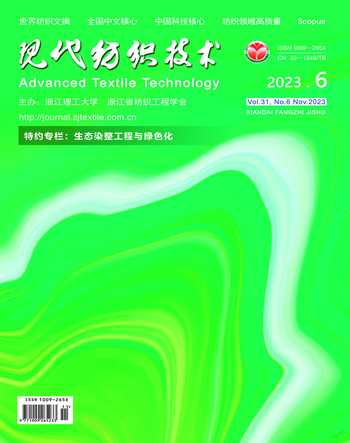RSM法协同正交试验优化棉型化汉麻织物的制备工艺
2023-11-22孔令苹王大伟孙丹亢福行
孔令苹 王大伟 孙丹 亢福行
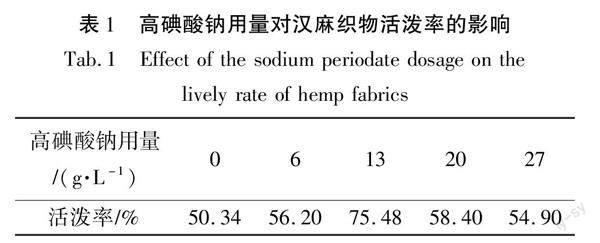
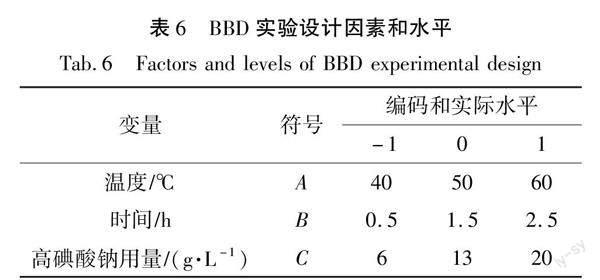
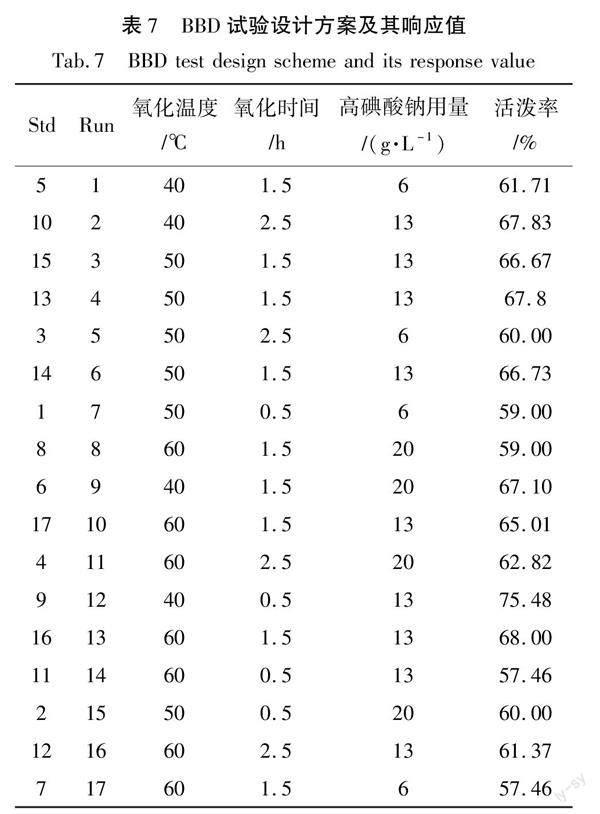
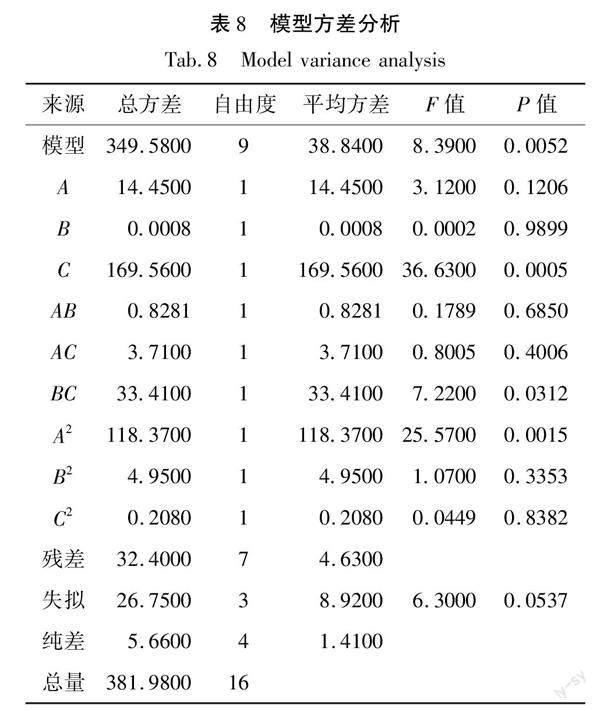
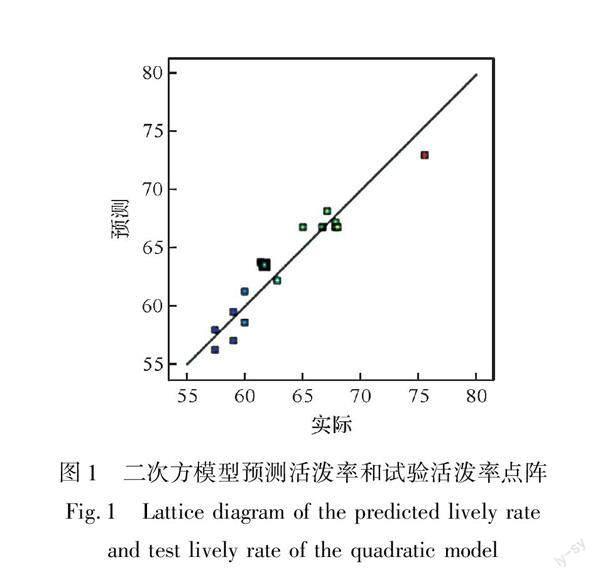
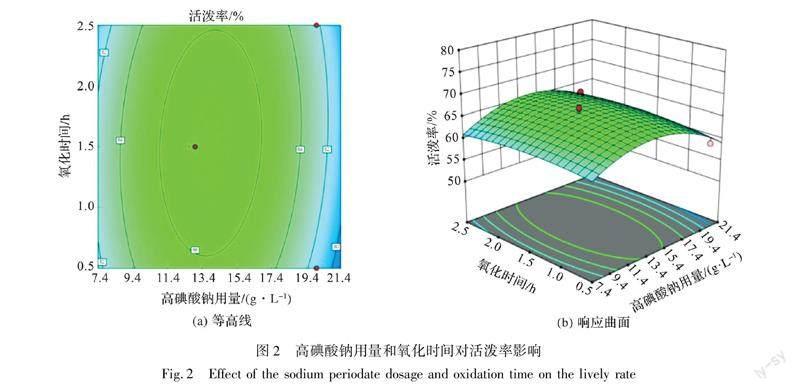
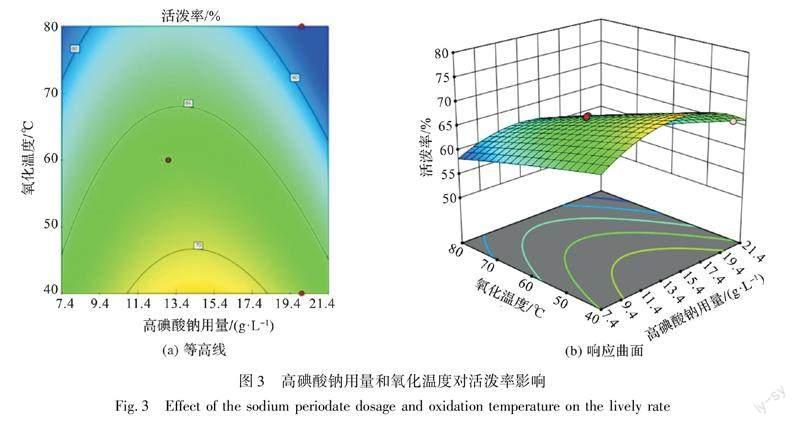
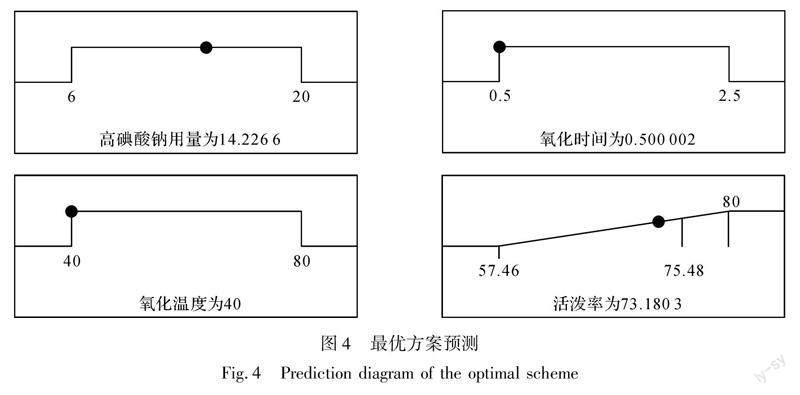
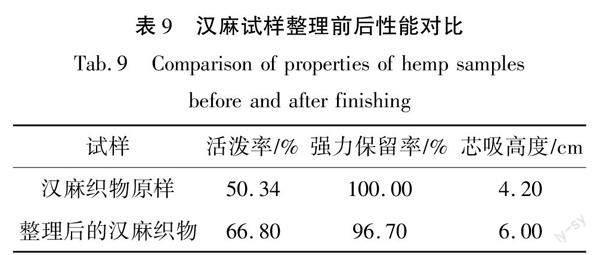

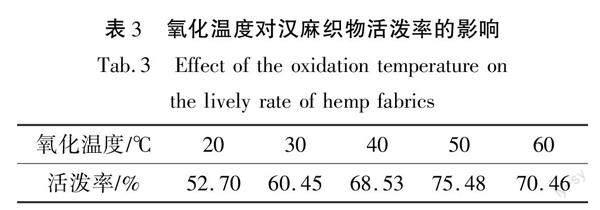
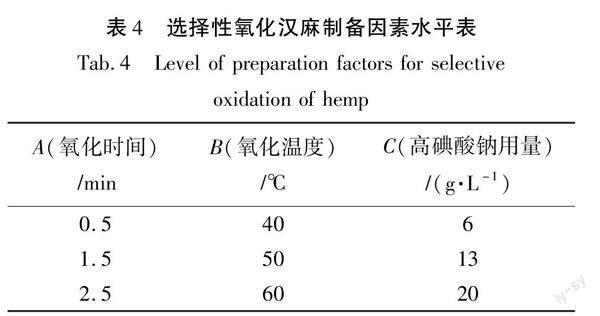
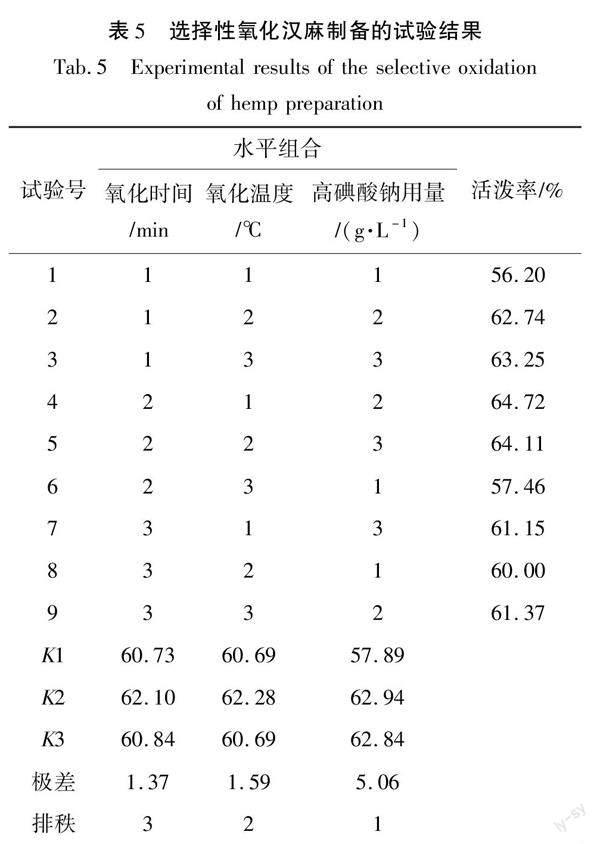
摘 要:为充分开发汉麻的应用价值并获得较柔软的棉型化汉麻织物,通过进一步优化选择性氧化汉麻织物制备工艺方案,在单因素方案和正交试验设计的基础上协同利用BBD试验和RSM分析法,以活泼率作为响应值,回归分析高碘酸钠用量、氧化时间、氧化温度各自变量因素及其交互作用影响。结果表明:正交设计和RSM法优化结果一致,柔软棉型化汉麻织物制备的最佳工艺为:高碘酸钠13 g/L,氧化时间1.5 h,氧化温度50 ℃。优化结果合理可行,在此优化条件下,棉型化汉麻织物活泼率增大、强力损失小、亲水性变好。
关键词:棉型化;汉麻;RSM法;柔软性;活泼率
中图分类号:TS121.9 文献标志码:A 文章编号:1009-265X(2023)06-0028-08
汉麻是中国的一种传统植物,属于天然纤维素纤维中开发较早的类别之一,汉麻植物纤维素主要由β-D-六环葡萄糖组成。由糖苷键形成的微晶的分子结构将使汉麻纤维具有更高的杨氏模量和聚合度[1-3],所以汉麻类纤维织物相对棉类织物柔软性欠佳,手感较差,硬度较高[4-7],因此优化汉麻织物柔软性,获得棉型化产品具有比较重要的意义。近年来,对环保和生命健康的关注与日俱增,随着国家“碳中和”口号的提出,汉麻纤维因具备降噪、不易电荷积聚、防紫外线辐射等特性,有着很广阔的发展潜力[8-9],因而被冠以 “天然纤维之王”的美称[10-11]。随着人们对汉麻纤维的关注度和研究的逐渐提高,目前的研究主要集中在脱胶、棉型化和汉麻精细化加工等方面[12-14]。
由于Response surface method(RSM)分析方法集成了实验设计和数学建模优化,因此可以以较少的实验和较低的时间成本对实验参数进行全面分析和研究[15],它将非线性函数或隐函数拟合为二次多项式函数[16],其局限性在于设计的实验点应包括最佳实验条件;而正交试验可以从全面试验中挑选出均匀分散具有代表性的特征点来试验[18]。在综合试验设计中RSM法和正交试验设计被广泛使用,但在实际应用中,将两者结合起来或采用多种优化设计方法对工艺参数进行研究的情况并不多见,本文创新性采用RSM法协同正交试验,通过单因素和正交试验选取包含最佳试验点的参数,再通过RSM法建模来优化筛选棉型化汉麻织物工艺方案,提高结果可信度,此研究对推动汉麻织物进一步综合利用开发棉型化和柔软性高价值化提供工艺参考。
1 试 验
1.1 试验材料及仪器
织物:汉麻织物(市售,1/1平纹,106×72根/10 cm,743.8 g/m2)
试剂:高碘酸钠(分析纯,天津市大茂化学试剂厂),无水乙醇(分析纯,天津科密欧化学试剂有限公司),去离子水(实验室自制)。
仪器:BS110S天平(北京多利斯天平有限公司),YG031Q型顶破强力(温州百恩仪器有限公司),WHL-25A台式电热恒温干燥箱(天津市态斯特仪器公司有限公司),YG821风格仪(莱州电子仪器有限公司),HHS-4S电子恒温不锈钢水浴锅(绍兴市亿纳仪器制造有限公司),YG(B) 871C型毛细管效应测定仪(绍兴力必信仪器有限公司)。
1.2 试验方法
1.2.1 原料预处理
参考麻类精炼工艺对汉麻织物试样进行预处理,放于低浓度NaOH、Na2SiO3和洗涤剂的混合溶液中进行搅拌浸泡一段时间,该步骤可以通过碱膨胀提高汉麻纤维的反应可及性,提高后续选择性氧化汉麻织物的醛基含量[19],然后清水洗涤数次,以去除织物表面残留的浆料、污渍、化学试剂等。
1.2.2 棉型化汉麻织物的制备
剪裁一定规格大小的汉麻织物试样,称取所需质量的高碘酸钠,并将其放入棕色锥形瓶中,加入裁剪好的汉麻织物试样,按照试验所需的不同温度不同时间条件下进行持续氧化反应,制得棉型化汉麻织物。
1.2.3 单因素试验
1.2.3.1 高碘酸钠用量的考察
氧化时间0.5 h,氧化温度40 ℃,其他条件固定的前提下,考察高碘酸钠用量0、6、13、20、27 g/L分别对汉麻织物柔软性的影响。
1.2.3.2 氧化时间的考察
高碘酸钠13 g/L,氧化温度40 ℃,其他条件固定的前提下,考察氧化时间0.5、1.5、2.5、3.5、4.5 h分别对汉麻织物柔软性的影响。
1.2.3.3 氧化温度的考察
高碘酸钠13 g/L,氧化时间0.5 h,其他条件固定的前提下,考察氧化温度20、30、40、50、60 ℃分别对汉麻织物柔软性的影响。
1.2.4 正交试验
选择性氧化汉麻织物柔软性的因素主要取决于NaIO4用量,氧化时间t,氧化温度T,在单因素试验基础上采用L9(34)正交表进行试验。
1.2.5 RSM试验
在单因素试验的基础上,以高碘酸钠用量、氧化时间和氧化温度作为考察因素,以表征柔软性的活泼率作为响应指标,采用Box-Behnken设计(BBD)响应面试验设计法来筛选考察因素的最优组合条件。
1.3 测试方法
1.3.1 活泼率测试
采用YG821风格仪,将汉麻织物试样盖上实验印泥,按照印泥缝线对折弯成弓状,夹入下夹钳中,带有传感器的压头从弓顶下压传导入电脑数据,得到活泼率数值,每個样品测量3次取平均值[20]。
1.3.2 顶破强力测试
根据GB/T19976-2005《纺织品 顶破强力测试 钢球法》使用YG031Q型顶破强力仪试验,按照式(1)计算纺织品强力保留率。
R/%=F1/F0×100(1)
式中:R为强力保留率;F0为初始样品的顶破强力;F1为整理后试样的顶破强力。
1.3.3 芯吸测试
用YG(B) 871C型毛细管效应测定仪测定汉麻织物处理前后的芯吸高度,样品尺寸为25 mm×200 mm,测试液温度为25 ℃,测试时间为30 min。
2 结果与分析
2.1 单因素试验结果
2.1.1 高碘酸钠用量对汉麻织物柔软性影响分析
高碘酸钠用量对汉麻织物活泼率的影响见表1,由表1数据可知,活泼率随高碘酸钠用量先升高再下降,在13 g/L时达到最大,因此选择6、13、20 g/L3个水平进行正交试验和响应面优化设计分析。
2.1.2 氧化时间对汉麻织物柔软性影响分析
表2为氧化时间对汉麻织物活泼率的影响,可知活泼率受氧化时间影响不明显,综合考量,选择0.5、1.5、2.5 h 3个水平进行正交试验和响应面优化设计分析。
2.1.3 氧化温度对汉麻柔软性影响分析
表3为氧化温度对汉麻织物活泼率的影响,可知活泼率随氧化温度的升高先增大再下降,在50 ℃时活泼率达到较高水平,综合各种因素,选择40、50、60 ℃ 3个水平进行正交试验和响应面优化设计分析。
2.2 正交试验分析
表4为选择性氧化汉麻制备因素水平表,本试验在单因素考查的基础上采用L9(34)正交表,按表5进行9次试验,以活泼率作为响应指标,测定结果见表5。由表5可知各因素的影响顺序C>B>A,最优水平为NaIO4用量13 g/L,氧化温度50 ℃,氧化时间1.5 h。
2.3 响应面分析法优化制备工艺
2.3.1 响应面设计试验(BBD)及结果
采用BBD试验设计法,以高碘酸钠用量、氧化时间、氧化温度作为自变量,以选择性氧化后汉麻織物试样的活泼率为响应值,BBD实验设计因子和水平见表6,BBD试验设计方案及其响应值结果见表7,由表7可知试验运行了17次方案。
2.3.2 以BBD试验为基础的响应面方差分析
利用Design Expert11软件,输入各组试验的各个因素水平和相应的响应值结果,对试验结果进行响应面分析,并对各影响因素水平进行方差分析,结果见表8。
表8为模型方差分析见,可知模型中的F值为8.39,P值为0.0052<0.05,表明该模型是显著的。从F值的大小可以判断出各因素对活泼率影响的显著性,C为显著影响因素,对活泼率的影响程度为C>A>B,即高碘酸钠用量是重要变量,其次是氧化温度,再次是氧化时间,这与正交试验的结果相一致。失拟检验的概率值P为0.0537,0.05<P<0.1,虽然失拟检验结果不显著,但相对不是很理想。由于失拟分析结果显示为不显著,因此该二次方模型可以准确地描述实际活泼率。通过随机分布预测活泼率和实际活泼率的点结果见图1。
二次方模型预测活泼率和试验活泼率点阵如图1所示,所有的点都散落在直线附近,这表明预测活泼率和实际活泼率值吻合度较高。所建立的模型能很好反映试验数据,回归方程拟合度良好,试验误差小[17],利用统计分析程序对17个试验点进行二次回归拟合,得到响应面回归模型方程如下:
LP=66.84+1.34A+0.01B-4.6C+0.455AB-0.9625AC+2.89BC-5.3A2-1.08B2-0.222C2
2.4 因素等高线图和响应曲面图分析
用Design Experts11对响应值活泼率模型进行分析,绘制产生交互作用两因素间的等高线图和响应曲面图。已知等高线形状反映了两个因素间的交互作用,等高线为椭圆形或马鞍形表明因素间的交互作用越明显,登高线为圆形,表明因素间的交互作用不显著;响应曲面坡度代表着因素水平变化对响应值影响的敏感程度,越陡表示变化影响越敏感[14]。
2.4.1 高点酸钠用量和氧化时间的交互作用
由图2(a)可以看出为椭圆形等高线,表明高碘酸钠用量和氧化时间对响应值活泼率有较强的交互作用。当高碘酸钠用量11~15 g/L,氧化时间在0.5~2.5 h时,汉麻织物能够获得较高的活泼率。当高碘酸钠用量在13 g/L时,最接近最佳点。图2(b)的响应曲面图可以看出,随着高碘酸钠用量的增加和氧化时间延长,活泼率先变大再变小。
从曲面弧度可以看出,高碘酸钠用量要比氧化时间对活泼率影响大。当高点酸钠用量固定时,随着时间的延长,汉麻织物的活泼率变化不显著,从充分反应角度考虑,氧化时间选择1.5 h。
2.4.2 高点酸钠用量和氧化温度的交互作用
由图3(a)可以看出,等高线的形状为弯曲线,表明高碘酸钠用量和氧化温度对响应值活泼率有一定的交互作用,当氧化温度小于60 ℃时,等高线线密度较密。由图3(b)可以看出,当高碘酸钠用量固定时,随着氧化温度的增大,活泼率是逐渐减小的。因此,考虑到能耗经济和充分反应等方面的因素,氧化温度选择50 ℃。
2.5 以BBD试验为基础的响应面最优方案预测
用Design Experts11软件对响应值活泼率模型分析得出最优方案预测,如图4最优方案预测图4所示。
由于氧化时间和氧化温度的交互作用不明显,暂不做分析。通过对比发现分析结果与最优预测图相一致。
2.5 整理前后汉麻织物试样性能对比
测定整理前后汉麻织物的活泼率和顶破强力进行对比分析,结果见表9。
由表9可以看出,经RSM法协同正交试验优化的汉麻织物活泼率明显升高,表明汉麻织物手感上变得更加柔软活络,强力保留率略有下降,芯吸性有所提高。
3 结 论
本试验以活泼率作为评价指标,针对NaIO4用量、氧化时间、氧化温度 3个因素进行单因素考察,正交试验筛选出相关因素的最佳水平,并在此基础上基于BBD实验设计原理,建立活泼率为响应值的工艺数学模型进行RSM试验优化,通过Design Expert软件分析3个因素及交互作用对活泼率的影响,得到了优化工艺方案为:高碘酸钠13 g/L,氧化时间1.5 h,氧化温度50 ℃,优化结果与正交试验结果一致,两种试验方法的结合使优化结果更具代表性和说服力。和未处理原样对比,该工艺条件下的活泼率指标较好,手感更柔软活络,弹性好,成品棉型化较好,并且强力损伤较小,亲水性较好,表明该设计优化分析工艺模型具有一定的指导意义。
参考文献:
[1]叶剑新.长短亚麻针织物加工及性能研究[D].上海:东华大学,2009.
YE Jianxin. Study on Processing and Properties of Line and Linen Tow Knitted Fabrics[D]. Shanghai: Donghua University, 2009.
[2]魏帅男.纳米银溶胶的制备以及对亚麻的功能整理[D].上海:东华大学,2017.
WEI Shuainan. Synthesis of Nanometer Solvercolloid and Functional Finishing to Linen[D]. Shanghai: Donghua University, 2017.
[3]兰红艳,张延辉.麻类纤维的性能及其应用[J].上海毛麻科技,2009(3):1-5.
LAN Hongyan, ZHANG Yanhui. Performance and application of bast fiber[J]. Shanghai Wool & Jute Journal, 2009(3): 1-5.
[4]鞠金星,季英超.大麻纱线的柔软整理[J].毛纺科技,2012,40(6):44-46.
JU Jinxing, JI Yingchao. Softness finishing of hemp yarn[J]. Wool Textile Journal, 2012, 40(6): 44-46.
[5]鞠金星,王宝权,吕站逵,等.大麻纱线的堿改性柔软整理[J].大连工业大学学报,2012,31(3):211-214.
JU Jinxing, WANG Baoquan, LU Zhankui, et al. Alkali modification and softening finish of hemp yarn[J]. Journal of Dalian Polytechnic University, 2012,31(3):211-214.
[6]黄翠蓉,钟安华,王宝根.大麻织物的碱改性柔软整理[J].印染,2004(8):18-20.
HUANG Cuirong, ZHONG Anhua, WANG Baogen. Alkali modification and softing finish of hemp cloth[J]. China Dyeing & Finishing, 2004(8): 18-20.
[7]姚穆.纺织材料学[M].3版.北京:中国纺织出版社,2009.
YAO Mu. Textile Materials[M]. Third Edition. Beijing: China Textile & Apparel Press, 2009.
[8]贾丽华,陈朝晖,高洁.亚麻纤维及应用[M].北京:化学工业出版社,2007.
JIA Lihua, CHEN Zhaohui, GAO Jie. Flax Fiber and Its Application[M]. Beijing: Chemical Industry Press, 2007.
[9]N.P.Ingle,张子涛,纪晋敏.大麻:未来最有前途的纤维素纤维[J].国外纺织技术,2001(1):7.
N.P. Ingle,ZHANG Zitao, JI Jinmin. Cannabis: The most promising cellulose fiber in the future[J]. Textile Technology Overseas, 2001(1): 7.
[10]张建春,张华.汉麻纤维的结构性能与加工技术[J].高分子通报,2008(12):44-51.
ZHANG Jianchun, ZHANG Hua. Structure and performance of China-hemp fiber and process technology[J]. Polymer Bulletin, 2008(12): 44-51.
[11]张毅,张瑞成,卓桂容,等.漆酶/超柔软油精复合处理纯大麻织物的性能[J].印染助剂,2019,36(6):53-56.
ZHANG Yi, ZHANG Ruicheng, ZHUO Guirong, et al. Properties of pure hemp fabric treated with laccase/super softner[J]. Textile Auxiliaries, 2019, 36 (6): 53-56.
[12]张金秋,张华,郝新敏,等.大麻纤维高温煮练时间与脱
胶质量的关系[J].纺织学报,2006(2):81-83.
ZHANG Jinqiu, ZHANG Hua, HAO Xinmin, et al. Relationship between high temperature scouring time and degumming quality of hemp fiber[J]. Journal of Textile Research, 2006(2): 81-83.
[13]张金秋,张建春.精细化加工对大麻纤维理化性能的影响[J].纺织学报,2009,30(11):81-87.
ZHANG Jinqiu, ZHANG Jianchun. Effect of refined processing on physicochemical properties of hemp fibers[J]. Journal of Textile Research, 2009,30(11):81-87.
[14]高俊,王雪燕.响应面分析法优化棉针织物金属配合物低温漂白工艺[J].染整技术,2016,38(7):25-30.
GAOJun, WANG Xueyan. Optimization of cotton knitted bleaching process with low tempetature metal complexes by response surface analysis[J]. Textile Dyeing and Finishing Journal, 2016, 38(7): 25-30.
[15]胡成旭,侯欣彤,冯永宁,等.响应面法优化云芝多糖提取条件的研究[J].食品工业科技,2007,28(7):124-126.
HU Chengxu, HOU Xintong, FENG Yongning, et al. Optimization of extraction conditions of polysaccharide from Coriolus versicolor by response surface methodology[J]. Science and Technology of Food Industry, 2007, 28(7): 124-126.
[16]解艷彩.基于响应面法的机械结构可靠性灵敏度分析[D].长春:吉林大学,2008.
XIE Yancai. Base on Response Surface Methodology Mechanical and Structure Reliability Sensitivity Analysis[D]. Changchun: Jilin University, 2008.
[17]任天宝,马孝琴,徐桂转,等.响应面法优化玉米秸秆蒸汽爆破预处理条件[J].农业工程学报,2011,27(9):282-286.
REN Tianbao, MA Xiaoqin, XU Guizhuan, et al. Optimizing steam explosion pretreatment conditions of corn stalk by response surface methodology[J]. Transactions of the Chinese Society of Agricultural Engineering, 2011,27(9):282-286.
[18]罗云云,杜伟锋,应泽茜,等.响应面法协同正交试验设计优化薏苡仁多糖提取工艺研究[J].中华中医药杂志,2019,34(10):4847-4851.
LUO Yunyun, DU Weifeng, YING Zexi, et al. Optimi-zation of extraction process conditions of coix seed polysaccharide by response surface method and orthogonal design of experiment[J]. Chinese Journal of Traditional Chinese Medicine and Pharmacy, 2019, 34(10): 4847-4851.
[19]王浩,林红,陈宇岳.碱预处理对棉纤维选择性氧化的影响[J].纺织学报,2008,29(8):18-22.
WANG Hao, LIN Hong, CHEN Yuyue. Effect of alkali pretreatment on selective oxidation of cotton fibers[J]. Journal of Textile Research, 2008, 29(8): 18-22.
[20]余序芬.纺织材料实验技术[M].北京:中国纺织出版社,2017.
YU Xufen. Experimental Technology for Textile Materials[M]. Beijing: China Textile & Apparel Press, 2017.
To optimize the preparation process of cotton-shaped hemp fabrics with the RSM method and orthogonal tests
KONG Lingping WANG Dawei SUN Dan KANG Fuhang
Abstract: The single fiber length of hemp is short, and the content of hemicellulose and lignin is higher than that of other hemp fibers. There are problems such as difficulty in degumming and poor fiber quality after degumming. The produced hemp yarn has a low count, and the hemp fabric has a rough and hard feel. Due to the rich resources of hemp in Northeast China, the single fiber length and fineness of hemp are similar to those of cotton, and there is no itching sensation compared to other hemp types. In order to make full use of hemp, improve the softness of hemp fabrics, and increase product added value, we conducted optimization research on the processing conditions of cotton shaped hemp fabric.
Firstly, single factor experiment was conducted to investigate the effects of the sodium periodate dosage, oxidation time, and oxidation temperature on fabric softness. Based on this investigation, representative sodium periodate dosage, oxidation time, and oxidation temperature experimental conditions were selected from comprehensive experiments according to orthogonality (evenly dispersed, and comparable in integrity) for orthogonal test analysis at three factors and one level. Because response surface methodology is an optimization method that integrates experimental design and mathematical modeling, it can provide intuitive contour maps and three-dimensional stereograms, and can examine the interaction between influencing factors. This method not only establishes a prediction model, but also tests the adaptability of the model, the significance of the model and coefficients, and the mismatched terms. We further performed analysis of variance and model diagnosis. However, the premise of response surface optimization requires that the experimental points designed should contain the optimal experimental conditions. In order to obtain the optimal results and compensate for this limitation of response surface optimization, we adopted the experimental analysis method of response surface design and orthogonal experimental design using the activity rate as the response value, verifing that the selected experimental conditions are the parameters containing the optimal experimental points orthogonal experimental optimization. Additionally, we used response surface optimization to screen the optimal process parameters for sodium periodate dosage, oxidation time, and oxidation temperature, improving the reliability of the experimental optimization results.
Through comprehensive consideration of the results of single factor tests on fabric softness at three factors: sodium periodate dosage, oxidation time, and oxidation temperature, and three levels of optimal design for orthogonal tests: a sodium periodate dosage of 6, 13 g/L, and 20 g/L were selected; oxidation time: 0.5, 1.5, 2.5 h; oxidation temperature: 40, 50, 60 ℃. With the L9 (34) orthogonal table and the activity rate as the response index, it can be seen that the order of influence of various factors is sodium periodate dosage>oxidation temperature>oxidation time. The optimal level requires a sodium periodate dosage of 13 g/L, oxidation temperature of 50 ℃, and a oxidation time of 1.5 h. A response surface design experiment was conducted on the basis of orthogonal experiments. With Design Expert 11 software, response surface analysis was conducted on the experimental results and variance analysis was conducted on the levels of various influencing factors. It can be seen that the model is significant; the significant degree of influence of various factors on the activity rate is sodium periodate dosage>oxidation temperature>oxidation time, which is consistent with the results of orthogonal experiments. The probability value P of the mismatch test is between 0.05~0.10, being 0.0537, and the mismatch analysis result is not significant. Therefore, the quadratic model can accurately describe the actual activity rate. Analysis of factor contour plots and response surface plots showes that the amount of sodium periodate and oxidation time has a strong interaction on the reactivity of response values; there is a certain interaction between the amount of sodium periodate and oxidation temperature on the response value activity, but the interaction between oxidation time and temperature is not obvious. Through comparison, it is found that the analysis results are consistent with the optimal prediction chart. On this basis, it is found by comparing the reactivity, strength retention, and wicking height of hemp fabrics before and after process optimization that except for slightly lower strength, both the feel and water absorption of the fabrics are improved. The design optimization model has certain significance for improving the added value of hemp fabrics.
Keywords: cotton type; hemp; RSM method; softness; lively rate
收稿日期:20220000 網络出版日期:20230403
基金项目:黑龙江省省属高等学校基本科研业务费科研项目工业大麻专项(145109509)
作者简介:孔令苹(1989—),山东济宁人,讲师,主要从事生态纺织品方面的研究。
